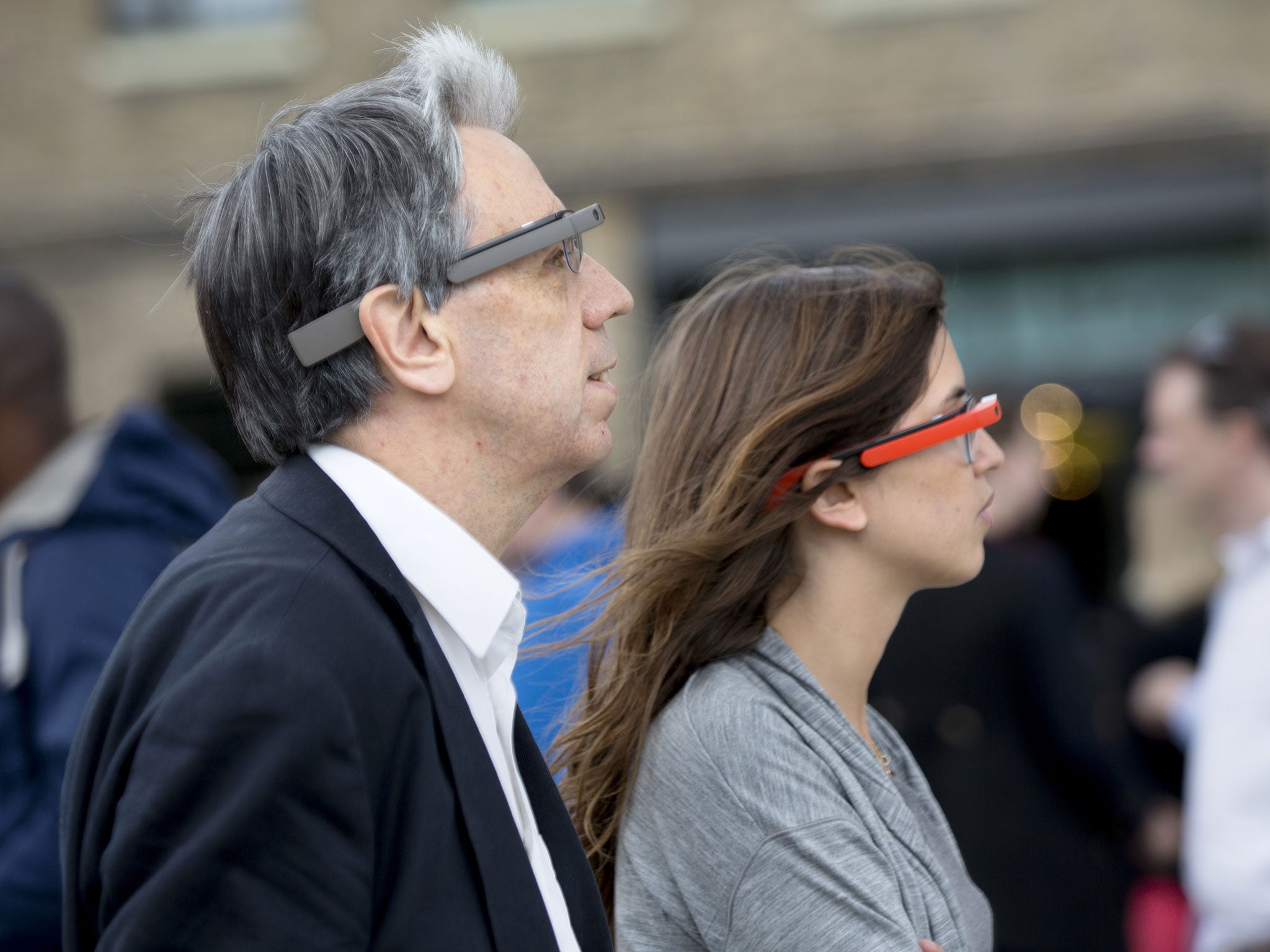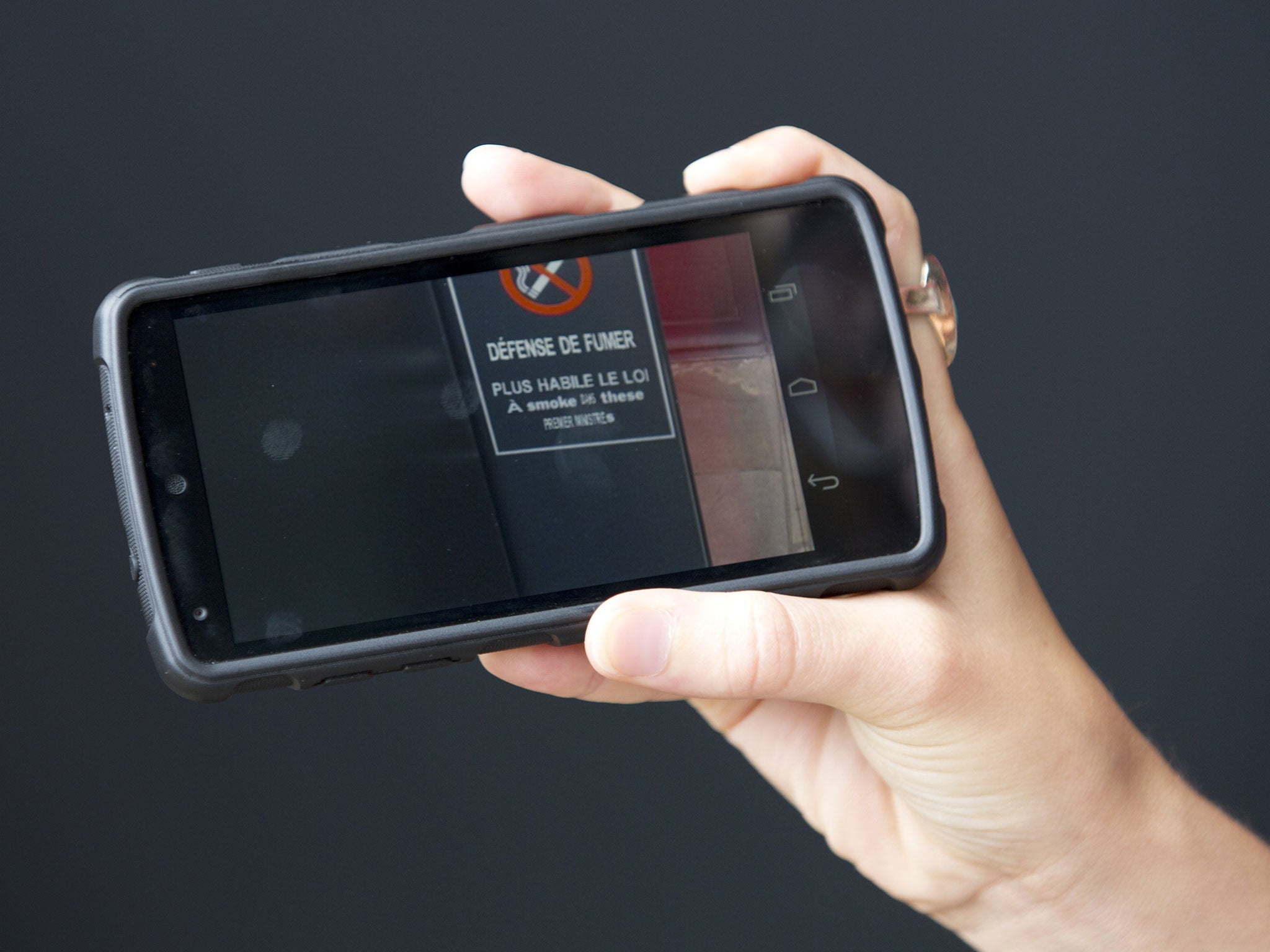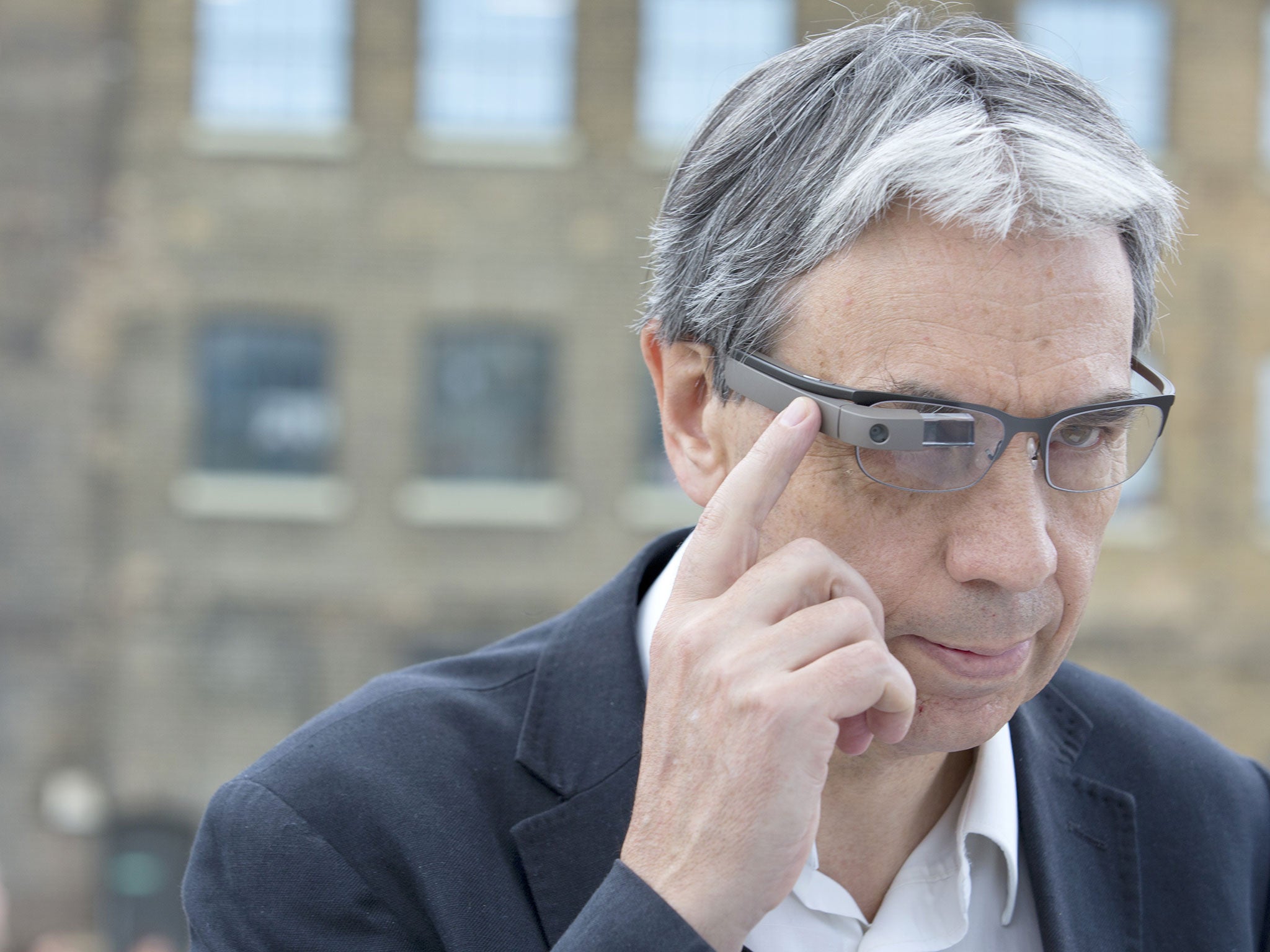Google Glass is here, but the view is more invalid than cyborg...
For £1,000, you can now sport the technology that promises to transform our lives, or destroy personal privacy, depending on your lookout

Your support helps us to tell the story
From reproductive rights to climate change to Big Tech, The Independent is on the ground when the story is developing. Whether it's investigating the financials of Elon Musk's pro-Trump PAC or producing our latest documentary, 'The A Word', which shines a light on the American women fighting for reproductive rights, we know how important it is to parse out the facts from the messaging.
At such a critical moment in US history, we need reporters on the ground. Your donation allows us to keep sending journalists to speak to both sides of the story.
The Independent is trusted by Americans across the entire political spectrum. And unlike many other quality news outlets, we choose not to lock Americans out of our reporting and analysis with paywalls. We believe quality journalism should be available to everyone, paid for by those who can afford it.
Your support makes all the difference.Look at your wrist. Do you see a watch? If you do, you have already embraced the idea of a wearable computer – although it’s sobering to recall that the widespread use of wristwatches by men came home from the battlefields of the First World War. As for eyeglasses, Venice had rules that governed the craft of making portable corrective lenses by the early 1300s. To stretch a point, woven cloth and stitched leather date back at least to the early Neolithic Age. Technology has empowered, enabled and enhanced the human body for 10,000 years and more.
Google describes its much-debated Glass device as “an extension of you”. An interesting choice of words: it was Marshall McLuhan – the Canadian communications guru of the sixties given a posthumous lease of life by the digital age – who half a century ago dubbed media as “the extensions of man”. Now, on a summer afternoon in King’s Cross near the UK “home base” for Google’s intelligent eyewear, this latest extension is perching on my nose. With the patient support of Alice, one of the company’s “guides” for gormless novices, I wander gingerly around the neighbourhood to see what it can – and cannot – do.
First announced in April 2012, trialled in the US a year ago, Google Glass remains a prototype product that (in this country) asks users to pay a cool £1000 for the privilege of joining its research team. The project wants, and needs, feedback from these “Glass Explorers” to iron out bugs and glitches, and to discover new applications, before the smart specs go on general sale.
From surgeons to chefs and firefighters, plenty of professionals have already begun to develop functions for a hands-free and voice-activated piece of kit that delivers information on the move, or on a task, without the need to touch or tap a screen. It does so either visually, to the small glass prism attached to the right lens of the 43-gram titanium frame (for the viewer, equivalent to a 25in HD screen 8ft away), or else verbally, via a tiny microphone that makes use of the bone-conduction technology found in hearing aids. Alice says she employs the mapping function to follow directions while cycling – a usage that calls for the kind of confidence few people on the planet will yet have with Glass.
First impressions? The flexible titanium frame is easy enough to wear, and can be customised – for an extra cost – with prescription or sunglass lenses. It took me a while to adjust the screen attachment that sits at the edge of your vision until it felt completely comfortable. Likewise, I proved pretty clumsy at first with the taps and slides in different directions that wake Glass up and then move it from one display to another – but all of that would become more familiar with practice.
The voice command “OK Glass” summons the genie from its lamp: take a photo or a video (with a default length of only 10 seconds); answer a question, via that ghostly bone-conducted voice, or do a Google search and show its results. At Granary Square, with a giant screen showing matches at Wimbledon, it updated me on tournament news and told me what I wanted to know about Thomas and Lewis Cubitt, the 19th-century master-builders of these palatial sheds and storehouses.
A few hitches delayed us: non-recognition of some voice commands, and problems with tethering Glass to data from a smartphone. For all the promise of a handset-free future, you can’t yet do all that much without an online connection. No doubt a lot of the delay came from my own beginner’s ineptitude. Some (for instance, failing to hear spoken responses) had to do with ambient noise and bustle; crowds, and glare, make it harder to get the messages.
I did have moments of Aladdin-like wonderment. Once I had got used to the maps (a favourite for many Glass pioneers), the blue line that leads towards your destination, modifying its course to your steps, does feel like an enchantment. Even more so the translation function, which – OK, after a bit of head-wagging – converted a “No Smoking” sign into “Défense de Fumer”. This was the nearest to a science-fiction scene during my stroll with Glass, as a mental function appeared to take material shape. An illusion, of course: I had merely searched a remote database and received the result. Still, I felt a slight frisson.

As a first-wave “explorer” with a gizmo on your face, you do fear looking like a bit of a wally. Alice told me that she would wear Glass in the park with her dog. “But in a club, no.” In uber-trendy King’s Cross, virtually no one batted an unenhanced eyelid – although a road worker did ask if we were reading maps. We were. In central London, you’ll need to sport more than a distended pair of specs to make a reputation for oddity.
The sheer conspicuousness of the device – a deliberate design – puts those early worries about privacy and surveillance into perspective. During video recording, the frame even lights up. A discreetly pocketed smartphone still offers many more options for covert information-gathering. Which also means that the noble calling of the citizen-journalist in the midst of riot or repression will probably have little use for Glass. A truncheon-swinging heavy would pick on its wearers first.
As for the panic about piracy in cinemas, the frame’s obtrusive visibility and limited recording capacity (max. 45 minutes of video) make this a pretty superfluous gadget in the techno-criminal’s toolbox. On etiquette in general, Google’s “Don’t be a glasshole” advice emphasises that users should switch off in the same places and for the same reasons as they would kill their phones. But then, after a short inactive spell, Glass goes to sleep anyway without prompting. Hence the need for regular side-taps to rouse the easily tired genie from its slumber.
After blundering around these prettified Victorian railway-lands – remnants of an earlier hot technology – did I feel like a visitor from the future? The opposite: more like an invalid than a cyborg. That hi-tech bulge over the right eyelid, with its need to be stroked and instructed, had an almost medical effect – and, after all, you are using a hearing-aid transducer. Rather than sensing yourself to be a superior, upgraded brain, you might feel (as I did) visibly impaired and in manifest need of prosthetic help. But then all our frail bodies and minds suffer various defects. Glass seeks in part to remedy one of them – the limits of our memory and knowledge without manual access to page or screen.
Surely here’s the rub. Any objection to Glass as an irritant distraction that seeks to bind our curiosity to a corporate database would apply to smartphones and laptops; in effect, to any portable technology. If you really wish to regain the innocence of the questing eye, then leave all your kit at home – even the wristwatch and phone. Try walking data-naked for a day: a temporary fast can be very therapeutic.
The prosthetic attachment of Glass to human eye and ear makes it look like some game-changing integration of individual mind into collective data. It is not. If it allows firefighters to navigate burning buildings via instant access to floor plans, or even home cooks to craft a curry without dunking recipe books or e-readers in indelible sauce, that sort of function should prove enough to carve out a secure niche – though not, I’m sure, at £1000 a throw. More than that it will not do.

If you worry about knowing too much but seeing too little, or about glimpsing reality through a fuzzy screen of corporate data, then to wear or to refuse to wear a £1000 pair of chatty super-specs will neither redeem nor ruin you. All the same, a much bigger picture does lie behind the Glass.
Over the past few months, Google has made a series of key appointments and acquisitions that signal its intention to recruit some of the planet’s leading thinkers in the field of artificial intelligence. It bought, for around £240 million, DeepMind – a British start-up researching the “learning algorithms” that enable computers to acquire or mimic the contextual knowledge that their human users have. That same principle lay behind its hiring of cognitive scientist Geoff Hinton, a pioneer of the artificial “neural networks” that can bring machine-learning closer to the workings of the brain.
Above all, in December 2012, Google appointed Ray Kurzweil as director of engineering. Without hyperbole, that was much like IBM signing Isaac Asimov or Arthur C Clarke as head of R&D in the 1950s. To be sure, Kurzweil has distinguished credentials as a hi-tech inventor – from flatbed scanners to text-to-voice software. But his cultural cachet rests on his role as far-out futurological guru who often patrols the edgelands where science proper and science fiction meet. Kurzweil believes that, by around 2029, the “singularity” will merge human and machine intelligence.
Then, in the Kurzweilian Utopia, we really would be wired up to the World Brain: a different kettle of petabytes from my request to Glass to show me “No Smoking” in French. Kurzweil’s ambitions tend to soar to a level somewhat beyond the “X Lab” lab workshops where Google thinks and crafts its cleverest toys – whether nose-supported mini-computers or self-driving cars.
Still, the near and the far can connect. For instance, Glass makes use of the natural-language, human-sensitive computing that lies at the heart of Kurzweil’s vision. Wrap that sort of capability – literally – around your brain, rather than at your fingertips, and fantasies of a cyborgian future do spring more readily to mind. However, fantasies they remain. For the moment, most of the Glass “explorers” will be happy enough to follow the blue line to their next rendezvous. Beyond that, God – or Ray Kurzweil – only knows.
Join our commenting forum
Join thought-provoking conversations, follow other Independent readers and see their replies
Comments